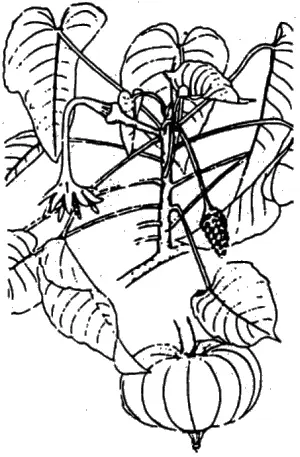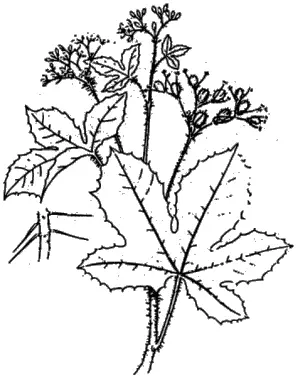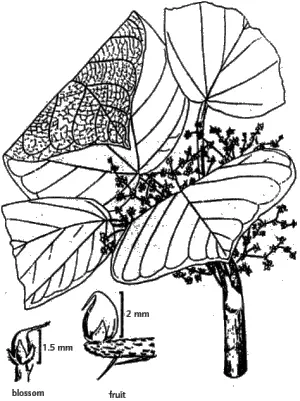Description:Small branching tree with light brown smooth bark and very small green blossoms. The fruits resemble small green apples. The tree contains a milky sap.
Effects:Chemical. On the skin the sap (after approx. one half an hour) induces a violent burning sensation, together with inflammations and vesicles or rashes with subsequent abrasion of the epidermis. If a small drop of the caustic latex or the smoke of the burning tree gets into the eyes, blindness can be the result. Even raindrops falling from a Manchineel tree can cause skin damages and severe eye irritation. All parts of the plant are also very poisonous and carcinogenic when ingested.
Measures:Washing of the skin, application of corticosteroid ointment. Rinse eyes immediately with water. Cover blisters sterilely. Tetanus prophylaxis, medical treatment.
Reference:Roth; Dahlgren
Similar plants:Most members of the Rubber Family (Euphorbiaceae) contain a milky sap which is skin-irritating and very poisonous, sometimes also carcinogenic

Hura crepitans L.
Euphorbiaceae family (Rubber family)

Synonyms: Sandbüchsenbaum (de), Jabillo (es)
Occurrence:Home of this tree is tropical America. Occasionally cultivated in India and other tropical countries. Grows at low altitudes.
Description:A tree up to 25 m tall. The bark is covered with lots of short spines. Inconspicuous reddish-brown blossoms. The woody fruits resemble small pumpkins and explode with a loud bang when ripe. Therefore, it can be dangerous to handle them. The tree contains a milky sap.
Effects:Chemically skin-irritating by the caustic latex. When brought into the eye it can cause cornea damages or even loss of sight. Also poisonous when ingested. The parts of this plant are poisonous also for fish and insects and therefore traditionally used as fish poison.
Measures:Washing of the skin, application of corticosteroid ointment. Immediate washing of the eyes with water, professional medical treatment.
Reference:Roth; Dahlgren; Behl
Similar plants:Most members of the Rubber Family (Euphorbiaceae) contain a milky sap which is skin-irritating and very poisonous, sometimes also carcinogenic.

Jatropha urens L.
Euphorbiaceae family (Rubber family)

Occurrence: Tropical America and the Caribbean at low and middle altitudes.
Description:Bush, shrub, or small tree with white blossoms and milky latex. The whole plant is covered with long rigid stinging hairs.
Effects:Mechanical-chemical through stinging hairs. A slight touch can cause severe burning and pain, often with insensitivity of the affected skin area for a day or longer. Frequently blistering.
Measures:Corticosteroid ointment, medical attention, Tetanus prophylaxis.
Reference:Dahlgren

Tragia spp.
Euphorbiaceae family (Rubber family)

Occurrence: Throughout India. The genus Tragia is represented there with different species.
Description:Perennial climber with stinging hairs. Leaves alternate and unpinnated or fingerlike 3-pinnated, bearing capsule fruits.
Effects:Mechanical-chemical by stinging hairs. Skin irritation and inflammation is possible after touching the plant.
Measures:Corticosteroid ointment, Tetanus prophylaxis.
Reference:Behl

Dendrocnide excelsa Chew.
Urticaceae family (Nettle family)

Synonyms: Giant Stinger (en)
Occurrence:Australia from the Bunya mountains in Queensland to Kiama in New South Wales. Widespread in rain forests, particularly on slopes and in canyons. Has related species in the whole Pacific area.
Description:Tree up to 40 m tall, with buttresses at the base of the trunk. Leave tops covered wirh fluffy hairs, bottom sides covered with stinging hairs. Male and female blossoms are on different specimens.
Effects:Mechanical-chemical by stinging hairs which break off when touched and inject a poison into the skin. Immediate burning sensation and itching will follow, including reddening and blistering. The burning can last for weeks. Even raindrops that fall from Dendrocnide can probably irritate the skin.
Measures:Tetanus prophylaxis, corticosteroid ointment, medical attention.
Reference:Flora of Australia
Similar plants:36 smaller Dendrocnide species, all with nettle hairs, in the Pacific region, including Dendrocnide corallodesme in Queensland, Australia, and New Guinea, in rain forests, growing 6 m tall with elongated leaves which resemble those of the Mango tree.

Dendrocnide moroides
Urticaceae family (Nettle family)

Occurrence: Queensland and East coast of Australia, from Cape York in the north to Victoria in the south. Along tracks, along the banks of creeks, and in rain forests.
Description:Tree up to 5 m tall with stinging hairs on leaves, young branches, and fruits. Fruits are edible.
Effects:Mechanical-chemical through stinging hairs. This is reported to be the most painful of all stinging trees. The stinging hairs break off when touched and inject a poison into the skin. Immediate burning sensation and itching will follow, including reddening and blistering. The burning can last for weeks. People can suffer even if they don't touch the plant. These trees continuously shed their stinging hairs. Staying close to a stinging tree for more than an hour can cause painful and continuous bouts of sneezing.
Measures:Tetanus prophylaxis, corticosteroid ointment, medical attention.
Читать дальше



















